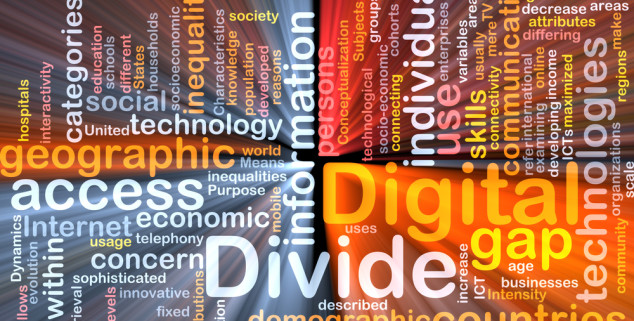Opinion
Crux of Charter merger: the Digital Divide
 Illustration by Kheng Guan Toh, via Shutterstock
Illustration by Kheng Guan Toh, via Shutterstock
The California Public Utilities Commission is about to make a landmark decision about the merger of Charter Communications, Time Warner Cable and Bright House Networks that will have a generational effect on closing—or possibly making permanent—the Digital Divide.
What is the Digital Divide and why is it so important? The Digital Divide is the gap between those who have access to the Internet and those who don’t. And it’s important because the Digital Divide is a mirror of the income divide and the opportunity divide. For low-income kids, adults, seniors, and disabled people, Internet access is now the straightest route into our digital economy—because now everything is online: homework, college and job applications, healthcare services, every single book in the public domain.
Given its economic benefits, isn’t home Internet access—especially to low-income people—an economic development no-brainer?
Awareness of the Digital Divide is at a high point. The White House Council of Economic Advisers recently issued the report “The Digital Divide and Economic Benefits of Broadband Access,” which states:
“Broadband provides numerous socio-economic benefits to communities and individuals, improving labor market outcomes for subscribers, increasing economic growth, providing access to better health care, and enhancing civic participation; academic research shows that using online job search leads to better labor market outcomes, including faster re-employment for unemployed individuals, yet because of a digital divide, low-income households are less able to use these tools than high-income households; unemployed workers in households with Internet were 4 percentage points more likely to be employed one month in the future than those in households without Internet. This difference persists over time.”
So how it is possible that more than one fifth of U.S. households are still offline—and that the Los Angeles Region lags behind the state average, with only 76 percent of households online and 10 percent of that number with smart phone Internet access only? Given its economic benefits, isn’t home Internet access—especially to low-income people—an economic development no-brainer? Isn’t access delayed, really just access denied?
These are the questions my network at the California Emerging Technology Fund is asking about the pending Charter merger. Charter has committed to an affordable broadband rate of $14.99 per month with a download speed of 30 Mbps for low-income households that have children on free-or-reduced school lunch and seniors on Supplemental Security Income, in order to support its offer to buy competing Internet providers. This is a very good rate for the speed, but Charter’s offer does not include all low-income households, particularly people with disabilities.
Charter refuses to be held accountable for broadband adoption goals, meaning it will not designate the number of low-income households it intends to connect. Nor will it commit funding for community-based organizations, which are crucial in reaching hard-to-reach customers. Nor will it agree to fund specific high-speed deployment in California’s rural areas or network upgrades. Most surprisingly, Charter will not extend its offer to low-income adults without children and people with disabilities.
But Charter is ready to fund a $67 billion acquisition of Bright House Networks and Time Warner Cable, pay up to $170 million in “Golden Parachute Compensations” to the top five executives of Time Warner, and pay up to $500 to buy existing Internet customers out of competitors’ contracts.
It would be one thing if Charter’s service area in Southern California was small. But the merged company will serve more than 6.5 million households and—most importantly—more than 2.3 million low-income households, a third of which are unconnected in the service “footprint.” Charter will become the dominant Internet provider in the Los Angeles Region, where 27 percent of the state’s residents live and where 33 percent of the state’s low-income people reside. The company, in essence, is buying the Digital Divide in Southern California.
The CPUC is in a position to require Charter to make significant public benefit commitments as conditions for approval of the mergers. After all, its mission is to “serve the public interest by protecting consumers and ensuring the provision of safe, reliable utility service and infrastructure at reasonable rates, with a commitment to environmental enhancement and a healthy California economy.”
To help achieve California’s statewide goal of 80 percent broadband adoption, the CPUC must require Charter to reach at least 45 percent of the 2.3 million low-income customers in its California service area. And to do this, Charter must establish a fund—as AT&T, SBC, and Verizon have previously done—to support community-based organizations, schools and libraries that can best reach low-income customers.
The CPUC is in the driver’s seat. If it doesn’t require Charter to make significant commitments to offer affordable Internet to all of its low-income households and if it doesn’t provide funds to connect low-income people—the CPUC will not serve the public interest or economic health of California. It will not be doing its job. And Charter will dominant the Los Angeles Region without actually providing its poor residents high-speed Internet.
—
Ede’s Note: Sam Overton, who served from 1976 to 2012 as a deputy attorney general in the California Department of Justice, is the former president of the City of Los Angeles Commission on Disability, where he advocated on behalf of rights for the disabled.
Want to see more stories like this? Sign up for The Roundup, the free daily newsletter about California politics from the editors of Capitol Weekly. Stay up to date on the news you need to know.
Sign up below, then look for a confirmation email in your inbox.

Leave a Reply